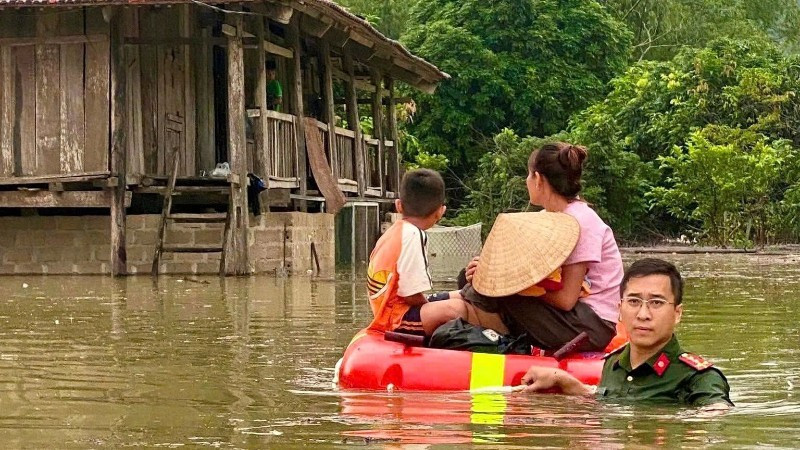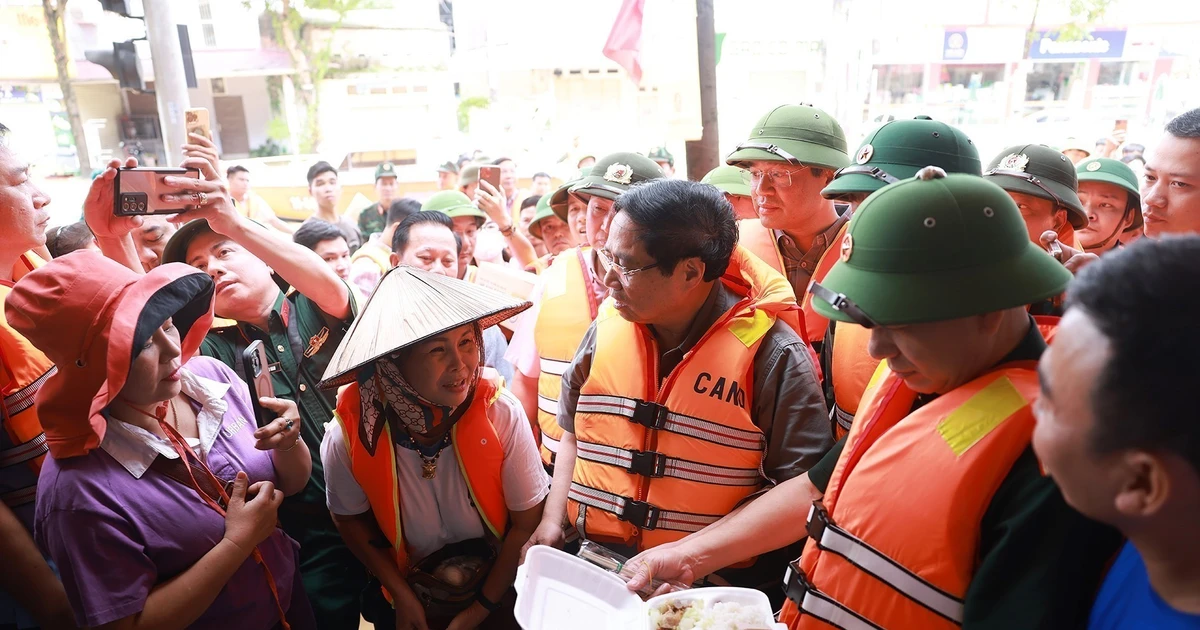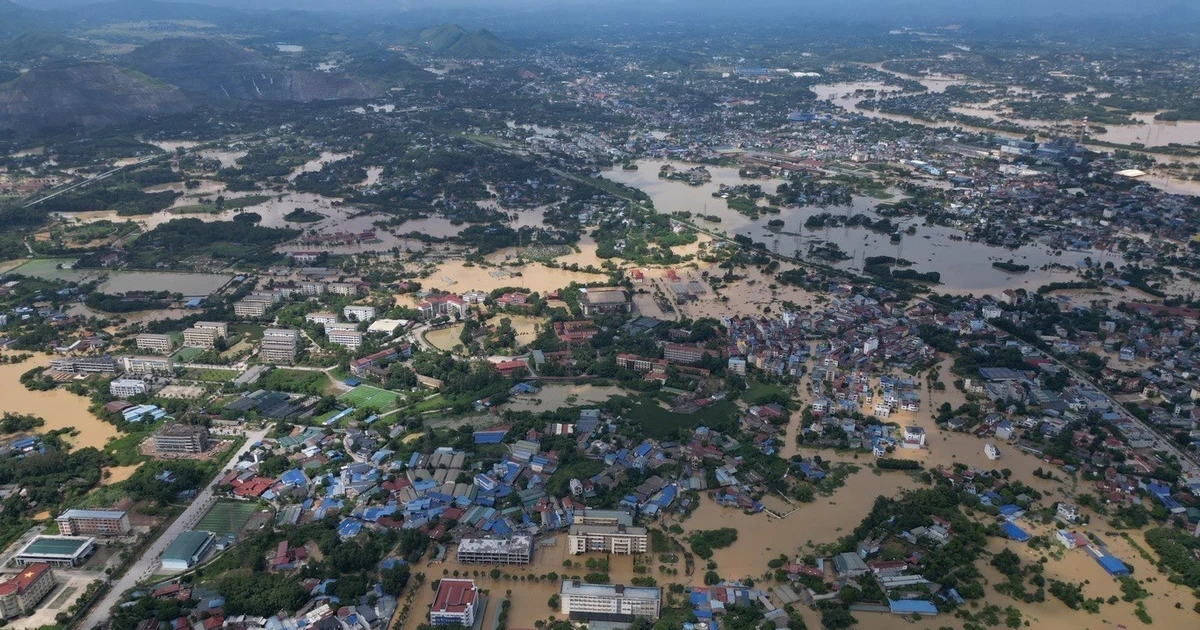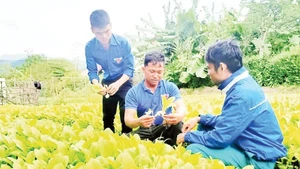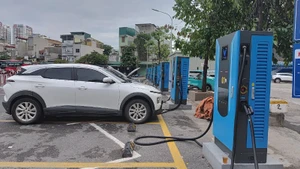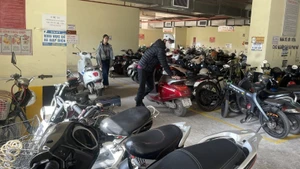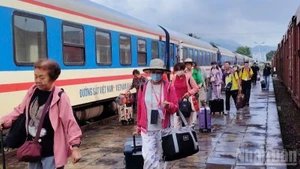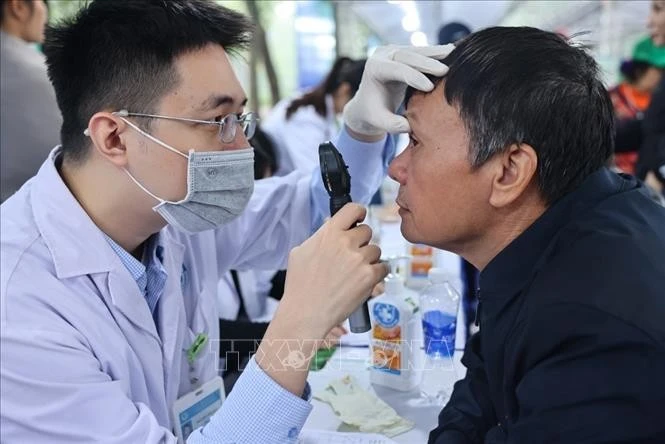Local authorities have mobilised all available forces and equipment for rescue and relief operations, helping residents overcome the aftermath of the disasters and stabilise their lives as soon as possible.
Party and State leaders have directly inspected affected areas, met with residents, and directed relief efforts. Political and social organisations, mass associations, and benefactors have provided thousands of free meals, bottles of water, instant noodles, and relief packages to isolated areas.
Proactively evacuating residents and minimising losses
At 5 am on October 8, the water level of the Cau River at Gia Bay Station (Thai Nguyen Province) rose to 29.9 metres, nearly 3 metres above the third alarm level and higher than the historic flood peak of 2024. Many communes and wards were deeply inundated, with several areas in Phan Dinh Phung Ward under more than two metres of water. Elderly residents in the area said this was the largest flood in the past 50 years.
Nguyen Thi Mai Anh, a resident of Phan Dinh Phung Ward, recounted: “The water rose so quickly that my family couldn’t prepare food and thought we would go hungry. Luckily, rescue teams reached us in time and helped us evacuate, bringing supplies for my elderly mother and two young children.”
By noon on October 8, the flood had caused significant damage in Thai Nguyen, leaving four people dead, two missing, over 5,400 houses submerged, 4,400 hectares of crops and aquaculture inundated, and more than 58,000 poultry swept away.
On the night of October 7, the Thai Nguyen Party Committee instructed that all meetings be suspended to focus on flood relief. Thousands of military and public security personnel were mobilised to safeguard vulnerable dykes such as those along the Cau River and Ben Tuong Bridge, while also rescuing residents and delivering essential goods to isolated communities.
Thai Nguyen Party Secretary Trinh Xuan Truong ordered the forces to reach the isolated areas by all means as soon as possible, ensuring no resident is left without food or shelter during the disaster.
On the morning of October 8, Prime Minister Pham Minh Chinh directly inspected flood response efforts in Thai Nguyen, urging ministries and local authorities to act swiftly in providing relief supplies to inundated areas. He also assigned the province to launch a project to build and upgrade 34 kilometres of dyke along both banks of the Cau River, to be completed by mid-2026.
Between the afternoon of October 6 and the morning of October 8, rising river levels caused 99 areas in Bac Ninh to be heavily flooded, 50 metres of dyke collapsed, 160 metres overflowed, and nearly 1,700 metres required emergency reinforcement. Over 9,000 hectares of crops and orchards were damaged, and nearly 80,000 livestock and poultry perished, many roads were cut off. But thanks to timely evacuation efforts, human casualties were minimised.
Ta The Hung, a Party official of Bac Ninh Province, shared emotionally: “The flood swept into my house while I was working over 40 kilometres away. Thanks to the local public security force’s prompt assistance, my mother and children were safely evacuated.”
In Tien Luc Commune, at 2 am on October 8, two sections of the protective dyke, totalling about 70 metres, broke, forcing the emergency evacuation of over 500 households. Commune Chairman Nguyen Van Long said: “All residents are now safe. We are continuing to relocate affected households and provide them with food and shelter, as the flooding remains widespread.”
On the afternoon of October 8, Deputy Prime Minister Nguyen Hoa Binh inspected flood response efforts in Bac Ninh and directed that the safety of human life must be the top priority, with all available resources mobilised for dyke protection and immediate incident response. Localities were instructed to quickly assist residents in restoring normal life and production when floods recede.
Joining hands to help residents resume normal life
In Cao Bang, torrential rain and flooding have submerged 7,500 houses and over 5,000 hectares of crops, 23 bridges were swept away, and 236 roads were blocked by landslides, causing an estimated loss of over 1.5 trillion VND (57 million USD). The province has mobilised nearly 5,000 officers, soldiers and militia members to remain on the frontline, using rubber boats to help residents move through inundated areas.
Sergeant Dinh Duc Nam from the provincial Fire Prevention and Rescue Police Department said: “For over a week, my teammates and I have been wading through floodwaters to support and assist people in danger.”
Colonel Van Khac Thanh, Commander of the Provincial Military Command, said: “The military and public security forces are present at almost all flooded areas, helping residents evacuate and relocate their property.”
During his inspection of Cao Bang Province on the afternoon of October 8, Deputy Prime Minister Tran Hong Ha emphasised the importance of rescue and relief operations to ensure the safety and well-being of flood-affected families. He urged the province to promptly assist severely affected households, including providing practical support to 800 traders at three markets in Thuc Phan Ward whose goods were swept away, with losses amounting to nearly 100 billion (3.8 million USD), and to help rebuild and repair damaged houses.
In Lang Son Province, the communes of That Khe, Trang Dinh, Huu Lung, Van Nham and Yen Binh were heavily flooded. Over 7,000 people from more than 2,000 households in Tan Tien, That Khe, and Trang Dinh Communes downstream of the Bac Khe 1 hydropower dam were urgently evacuated during the night of October 7 following a dam breach. The province mobilised 455 soldiers, 1,150 militia members, 750 public security officers, and dozens of vehicles and motorboats for rescue efforts.
Le Thi Phuong, a resident of Yen Binh Commune said: “The rescue forces arrived in time to help us move our belongings to higher ground. Later that day, the relief team brought essential supplies, helping us feel safer amidst the flood.”
Major General Pham Hai Chau, Deputy Director of the Department of Rescue and Relief under the Ministry of National Defence, inspected the Bac Khe 1 dam breach and instructed the province to act swiftly to ensure the safety of downstream areas.
Also on October 8, Deputy Prime Minister Ho Duc Phoc visited the affected sites, directing authorities to promptly supply sufficient food, drinking water and essential goods to isolated areas, ensuring no one is left hungry or without shelter. The Ministry of National Defence deployed four helicopters carrying emergency relief supplies to the isolated communes of Van Nham, Yen Binh and Tuan Son.
In Xuan Van Commune, Tuyen Quang Province, 50 households were affected, including 20 whose houses were struck by landslides and 30 located in high-risk areas that have been evacuated. Commune Chairman Ha Manh Linh said local forces and machinery were mobilised to clear debris and reopen roads as quickly as possible.
In An Tuong Ward, hundreds of cubic metres of earth slid into 40 homes. The authorities, along with the 247th Regiment and the 5th Defence Zone Command, assisted residents in cleaning mud and moving belongings. Ward Chairman Tran Song Ha said: “We proactively reviewed households at risk of flooding, conducted early evacuations, and continuously issued warnings via loudspeakers and local Zalo groups to minimise losses.”
In Dong Van Commune, over 2,000 cubic metres of rock and soil collapsed onto National Highway 4C, destroying the commune’s welcome gate. However, according to Commune Chairman Pham Duc Nam, the military, public security, border guards and residents quickly cleared debris and guided vehicles along detour routes.
